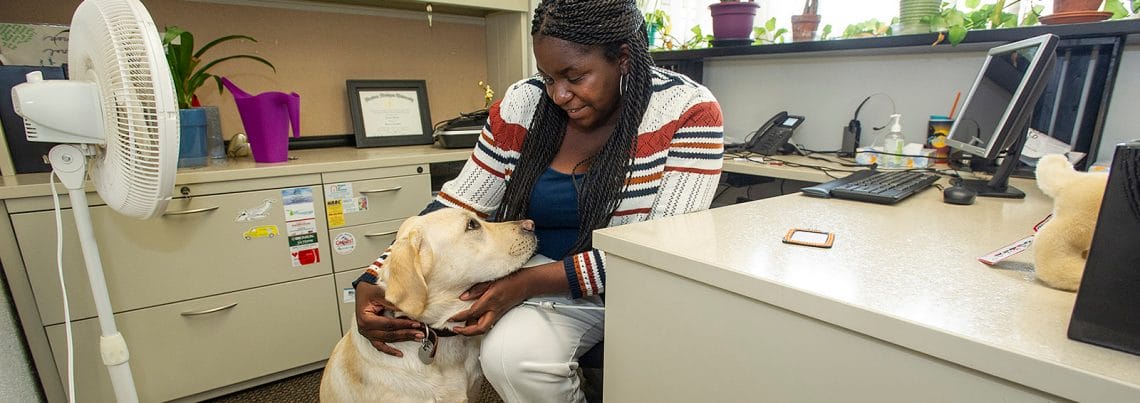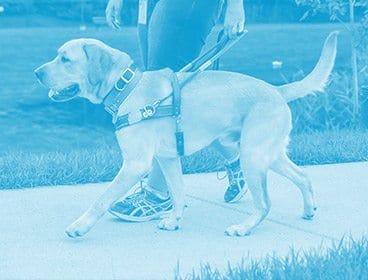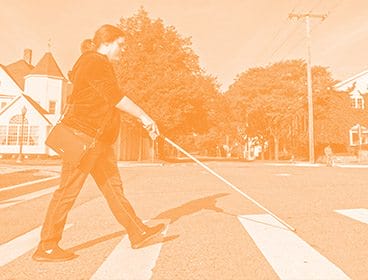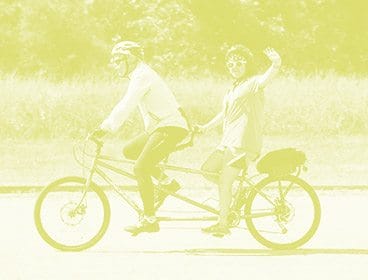
Leader Dogs in the Workplace
Whether life with a Leader Dog is new or you are an experienced guide dog handler, there will be some adjustment period for both you and your workplace. The following guide should help both you and your employer understand your needs and your dog’s needs as you integrate into the work environment.
New Leader Dog Handlers
Both you and your dog need time to adjust to the workplace and its routines. If it’s appropriate, it may help to temporarily alter the starting and ending times of your work day to times when the workplace is less congested. This way there will be fewer distractions and potential problems to interfere with the task of helping your dog learn the new environment.
If you are new to the workplace or need to learn new routes now that you will be accompanied by your Leader Dog, taking the time to get oriented and feel comfortable will be beneficial for you and your dog. Exploring the workplace on your own (with a human guide and/or a white cane) is fine, but the sooner you help your dog adjust to your work area, the better. If you need assistance learning new routes or areas, your employer should provide a sighted guide to help orientate you and your Leader Dog to the workplace. Since many people have not guided anther person as a sighted guide, you can offer these instructions.
Instructions for Sighted Guides
The sighted guide may offer his or her left arm. The person who is blind will grasp the arm just above the elbow and follow a half step behind. While using a human guide, the dog will be by their partner’s left side, but without the handle in the handler’s hand.
The sighted guide should describe the environment, indicating details such as floor texture, noise, time, distance and rate of travel pace. Attention should also be given to emergency exits.
Experienced Handlers
Experienced Leader Dog handlers may need to employ the above methods if the work environment is new to either you or your dog. The better a person’s orientation and mobility skills, the faster he or she will become familiar with a new environment. Once the Leader Dog handler is aware of the environment, it becomes a matter of demonstrating the routes to the dog.
Responsibilities of a Leader Dog Handler
Your responsibilities to your Leader Dog include general care, feeding, walking, correcting, praising and more. An important point of care that will affect your work day is the need for Leader Dog handlers to use a designated relief area for the dog, which you should discuss with your employer. Unless other arrangements are made, you are responsible for clean-up.
It’s a good idea to prepare an advance plan with a supervisor or co-worker in case you get sick or have an accident or another emergency. In many cases, dogs have been allowed to ride in an ambulance with a conscious handler. While hospitals offer the same access rights as other public places, there may be some restrictions.
Introductions to Co-workers
A lot of people will probably want to meet their new four-legged co-worker, but don’t let your Leader Dog get overwhelmed. Start with your supervisors and immediate co-workers, and try to use an informal setting with only a few people at a time.
Remind your co-workers to approach your dog calmly and quietly. Unusual attire that your dog might never have seen before, such as a welding mask, may make your dog uneasy. Your co-workers may want to give your dog treats and attention. Let them know that those things need to come from you first and foremost, and they should ask for permission before feeding or touching your Leader Dog. After initial introductions, your dog will settle into your workplace’s daily routines more quickly and easily if it receives limited attention.
Consider submitting and introduction of your guide dog and what it does for you to your company newsletter or another kind of internal correspondence. That way, co-workers who don’t see you and your dog on a regular basis can still learn how to interact with a guide dog in the workplace.
Situating Your Dog
Depending on the work environment, you and your supervisor will need to determine where to situate your Leader Dog during work hours. If your dog can’t be next to you during part or all of your workday, find a location where the dog will be safe and easily accessible to you. Pedestrians, tool carts, machinery, noise, chemicals and other debris can be distracting as well as harmful to the dog.
Before your guide dog training at Leader Dog is complete, you will receive a tie-down to keep your dog in a selected area. If you need to leave your Leader Dog in another room or unattended, giving your dog a safe chew toy (such as a durable nylon bone) and some soft background noise (a radio playing) will help keep it occupied and comfortable while you’re gone. Never let your dog roam around your workplace unsupervised.
Workplace Challenges
In spite of the best training and preparation, problems may happen. You are ultimately responsible for your Leader Dog’s behavior in the workplace. If your dog misbehaves, you should be the source of control, correction and praise. Your employer should not confuse your dog’s behavior with your job performance, but if your dog is acting inappropriately, it will probably impact your focus and productivity at work. Do your best to work with your employer to find solutions to any issues as quickly as possible to prevent one mistake from turning into a bad habit.
If you are having problems integrating your dog into your workplace and need guide dog-related assistance, contact us so that an instructor can review your situation and provide advice or additional assistance.
General Leader Dog Etiquette
Below are some basic guidelines for anyone who comes into contact with a guide dog. These may be helpful to share with co-workers who aren’t sure what to do.
- A Leader Dog is a working dog and should not be petted or called without their handler’s permission. A Leader Dog is on duty when in harness even when sitting or lying down.
- Avoid making eye contact with a working dog; even something as simple as eye contact is a form of attention and may distract the dog.
- Do not take hold of the Leader Dog or its harness without permission. Often, if a person who is blind person needs assistance, he or she will ask for it. If it appears the person needs help, ask first before acting.
- When providing directions to a person who is using a Leader Dog, speak to the person, not the dog. Be sure to use detailed, easy-to-follow indicators like, “Go north two blocks then east,” or “Turn left and go two blocks.”
- Please do not feed a Leader Dog whether on or off duty as the dog follows a veterinarian-prescribed diet.
Federal and state laws, including the Americans with Disabilities Act, protect guide dog handlers and provide direction to the general public.

Guide Dog
Guide Dog
Orientation and Mobility
Orientation and Mobility
